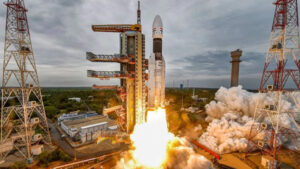DECEMBER 17, 2022

Within a week after the launch by Skyroot, space tech firms Pixxel and Dhruva Space launched their payloads on the Polar Satellite Launch Vehicle, the workhorse of ISRO. (File Shot used for representation)
Over the five decades, India’s space programme has progressed substantially under the guidance of Indian Space Research Organisation (ISRO), making the country as one of the world’s five most technologically advanced spacefaring nations.
2022 was highly successful for ISRO with a high percentage of successful launches, the largest commercial launch, contracting launch vehicles to private companies and launching rocket and satellite payloads for Indian private entities.
Space Economy
The global space economy is estimated to be worth $440 billion and India India is renowned internationally for its low-cost satellites and launch vehicles. Despite having the most accomplished space programme in the world, India’s space sector represents about 2 percent to 4 percent of the global space economy. To enhance India’s part of the global market, the government has begun space sector reforms to encourage, support, regulate, and authorise private businesses and startups to engage in space activities.
The Indian space economy is expected to reach US$12.8466 billion by 2025, according to a joint report by Ernst & Young (EY) and the Indian Space Association (ISpA), the primary industry organisation founded to represent the Indian space industry as a whole.
Following the successful launch of India’s first privately-built rocket, the Vikram-S, on November 18, the ambitions of several other entrepreneurs in the space technology industry have soared. These firms are developing a wide variety of space-related products, including rockets, satellites, and apps.
Within a week after the launch by Skyroot, space tech firms Pixxel and Dhruva Space launched their payloads on the Polar Satellite Launch Vehicle, the workhorse of ISRO.
The industry of space technology in India has been making incredible strides recently. According to the findings of Tracxn, the amount of money raised through crowdfunding in this sector shot up by 198.67 percent in 2021, hitting US$67.2 million across 11 rounds. This figure compares to the US$22.5 million raised through nine rounds in 2020. After the government started making moves to privatise the industry in 2021, the number of new businesses starting up in the space industry skyrocketed, going from 11 in 2019 to 47 in 2021, as stated in the Economic Survey of 2022.
Skyroot Aerospace, Pixxel, Dhruva Space, AgniKul Cosmos, SpaceKidz India, Aantriksh, Bellatrix Aerospace, Astrogate Labs, Kawa Space, Vellon Space, Blue Sky Analytics, and SatSure are among the Indian space tech businesses seeking to revolutionise the industry.
Promising Indian space tech firms
Agnikul Cosmos
Agnikul, based in Chennai and founded in 2017 by Srinath Ravichandran, Moin SPM, and Professor SR Chakravarthy, is developing a private small satellite launch vehicle. Agnibaan, its primary product, is a smallsat launch vehicle capable of transporting up to 100 kg of cargo to Low Earth Orbits (LEO). Earlier in 2021, the startup test-fired the world’s first 3D-printed rocket engine, Agnilet, and stated it would conduct additional tests during the remainder of 2021. It raised US$11 million in a Series A investment round headed by Mayfield India in May of last year. Existing investors, such as pi Ventures, Speciale Invest, and Artha Venture Fund, also contributed. In March 2020, the space tech business earned US$3.1 million in pre-series A funding, and in 2019, Speciale Invest funded its seed round. In September 2021, it signed a memorandum of understanding (MoU) with the Department of Space to gain access to ISRO’s facilities and expertise to conduct tests for its 3D-printed single-piece semi-cryo engine and other technologies.
Dhruva Space
Dhruva Space is focused on developing full-stack space engineering solutions. It was founded in 2012 by Sanjay Nekkanti, an alumnus of SRM University, and later joined by Abhay Egoor, Krishna Teja, and Chaitanya Dora, all alums of BITS-Pilani. The headquarters of the space tech startup is in Hyderabad, India, and Graz, Austria. The platform provides application-agnostic, application-modular satellite platforms to facilitate faster, more dependable, and cost-effective access to space. In addition to providing launch and ground station services, Dhruva Space provides clients with a single point of access for owning and running space-based assets. The startup is involved in the space, launch, and ground segments and serves both civil and military clients globally. Dhruva Space has already begun fostering industry-academic ties and has partnered with BITS – Hyderabad and IIT Hyderabad. It is fostered in the Business Incubation Centre of the European Space Agency in Austria, giving them access to the European market and technology. In October 2021, led by IAN Fund and Blue Ashva Capital, it raised Rs 22 crore.
SatSure
SatSure, a Bengaluru-based space tech startup founded in 2017 by Prateep Basu, Rashmit Singh Sukhmani, and Abhishek Raju, is a decision intelligence company that operates at the intersection of space technology, artificial intelligence, and sustainability. It offers three key products: the freemium SatSure Sparta platform for agriculture and climate insights; the life cycle risk monitoring and business intelligence product SatSure SAGE for agriculture financial services; and the high-resolution satellite imagery-based infrastructure change detection platform SatSure SKIES. Using satellite data, the platform generates decision insights for the banking and insurance industries. Among others, the firm has partnerships with ICICI Bank, Reliance General Insurance, and Samunnati Finance. It raised an undisclosed amount of equity capital in a transaction led by Baring Private Equity India in November 2021. The funds will be used to increase the company’s personnel, broaden its product offering, and expand its international business footprint. It is also seeking to capitalise on its recently announced high-resolution optical and multispectral payload demonstration mission in orbit.
Astrogate Labs
Astrogate Labs, a Bengaluru-based space technology firm founded in 2017 by Nitish Singh and Aditya Kedlaya, develops essential technologies in optical/laser communication terminals. It is constructing a comprehensive network of optical/laser communication systems to address the issue of high-speed space communication. Astrogate Labs’ space technology platform enables satellite constellation operators to securely and inexpensively transmit more data from orbit to earth. Currently, the company has a qualified space-to-ground laser communication solution with its “smallsat optical downlink terminal” that can be easily integrated on any small/nanosatellite platform and provides up to one Gbps of the downlink. Additionally, the company intends to offer space-to-space laser communication terminals. The technique resembles terrestrial fibre optics, which has become pervasive. Astrogate Labs provides speeds comparable to fibre optics for satellite communication. Astrogate, a company in the space technology industry, asserts that it has refined its technologies and products over the past year and is concentrating on achieving flying heritage in 2022. The company is cooperating with satellite constellation operators for the early commercialisation/sales of their laser terminal and downlink services. The company has already established itself as a provider of end-to-end laser communication solutions, and it anticipates an increase in revenue in 2023 and beyond as it commercialises laser communication. In November 2020, the firm raised pre-Series A financing. Speciale Invest. Anicut Angel Fund and SuprValue led the investment. VCs have also co-invested in this round.
Pixxel
Launched in 2019 by 20-year-olds Awais Ahmed and Kshitij Khandelwal, the Los Angeles and Bengaluru-based space tech business Pixxel is constructing and deploying hyperspectral imaging satellites to create a global health monitor. It claims to have collaborated with prominent space organisations such as ISRO, NASA JPL, and SpaceX. Other investors include Lightspeed, Radical Ventures, Relativity’s Jordan Noone, Seraphim Capital, Ryan Johnson, Blume Ventures, Sparta LLC, growX ventures, Inventus Capital, and Omnivore VC. Pixxel asserts that its technology enables a variety of unique environment and sustainability use cases by enabling agriculture, oil and gas, mining, and environmental agencies to analyse geospatial composites of the earth’s surface in real time via an API (application programming interface). This degree of specificity will offer the government insights into controlling and managing risk activities across several industries. Recently, the company successfully retrieved its first hyperspectral satellite photos from a camera launched with partners NanoAvionics and Dragonfly Aerospace last year. It launched its first fully-fledged commercial satellite Shakuntala (Technology Demonstrator-2), using a SpaceX Falcon-9 rocket in April 2022. Shakuntala has one of the highest-resolution hyperspectral commercial cameras ever sent into orbit, taking it one step closer to constructing a 24×7 global health monitor. Traditional earth imaging takes data in the visible light range, which restricts potential applications. Hyperspectral imaging collects data across 40 times more wavelengths and has a multitude of applications in India, including monitoring methane emissions, measuring carbon sequestration, and monitoring disease outbreaks across agriculture. In March 2022, it raised US $25 million in Series A funding headed by Radical Ventures, a Toronto-based venture capital firm renowned for investing in entrepreneurs who employ artificial intelligence to revolutionise major sectors.
ISRO dominated the 2022 Indian Space charge
The 2022 space activity started for ISRO on February 14 with the launch of the PSLV-C52 with EOS-04 Satellite. In May, the agency tested a large human rated solid rocket booster for the Gaganyaan programme. In June GSAT-24 Communication satellite was launched on-board Ariane-V from Kourou, French Guiana, on June 23 2022 and in the same month the agency hosted its Technology Transfer Conclave.
In September ISRO demonstrated new technology with Inflatable Aerodynamic Decelerator (IAD), primarly meant for recovering spent rocket stages for relaunch. IAD was launched on a Rohini sounding rocket launched from TERLS, Thumba. The IAD was first folded and stored within the rocket’s payload bay. At approximately 84 kilometres in altitude, the IAD was inflated and plummeted through the atmosphere while carrying the payload of a sounding rocket. LPSC created the pneumatic system used for inflation. The IAD has systematically decreased the payload’s velocity via aerodynamic drag and has followed the planned trajectory. This is the first time an IAD has been specially designed for spent stage recovery.
In October, ISRO created another milestone by launching 36 OneWeb Satellites on using the LVM3 rocket, also sometimes called the GSLV. This launch by ISRO and NewSpace India Limited (NSIL) represents one of India’s largest commercial contracts.
In November, ISRO launched the RH200 – a multipurpose sounding rocket – from Thumba at TERLS, marking its 200th consecutive successful launch.
Setbacks
There were also set back for ISRO this year. ISRO prepared for the first developmental launch of the SSLV-D1/EOS-2 mission on August 7. The launch occurred at Sriharikota’s Satish Dhawan Space Centre. The Small Satellite Launch Vehicle (SSLV) D1/EOS-2 mission carried two satellites: the Earth Observation Satellite-2 (EOS-2) weighing approximately 135 kilogrammes and AzadiSAT weighing eight kilogrammes. The objective of the mission was to place the EOS-2 in a circular low-Earth orbit at the height of approximately 350 kilometres above the Equator and an inclination of 37 degrees. The initial phase of the mission was successful, as the launch vehicle operated without incident. However, the mission failed to place the satellites in their proper orbits, and the satellites were lost because they had already been separated from the launch vehicle.
The year ended for ISRO with the successful launch of PSLV-C54/EOS-06 Mission on November 26. ISRO’s workhorse PSLV-C54 successfully launched the EOS-06 satellite and eight nano-satellites into two separate SSPOs.
Courtesy/Source: The Financial Express / PTI

































































































